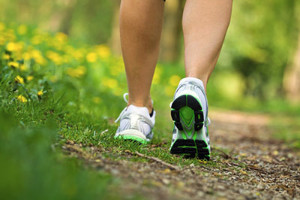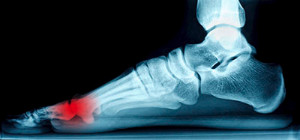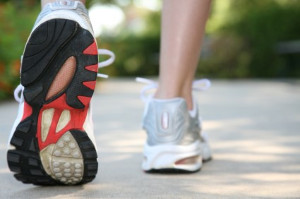Connect With Us
Blog
Items filtered by date: June 2017
Why You Should Avoid Sandals and Flip-Flops This Summer
 When the weather starts to warm up, you may be tempted to show off your feet with open-toed shoes. However, if you want them feeling healthy and fresh you should take extra precautions to make sure your feet are summer-ready. Wearing low-quality flip-flops and sandals without arch support may cause bunions, blisters, corns, and calluses, so it is important that you limit, if not avoid, wearing them during the summertime. In order to prevent conditions such as plantar fasciitis, you should choose a sandal that has cushioning and arch support so your feet are comfortable while you walk. Nevertheless, the amount of time you spend wearing flip-flops should be limited so that you can avoid injury and other foot conditions.
When the weather starts to warm up, you may be tempted to show off your feet with open-toed shoes. However, if you want them feeling healthy and fresh you should take extra precautions to make sure your feet are summer-ready. Wearing low-quality flip-flops and sandals without arch support may cause bunions, blisters, corns, and calluses, so it is important that you limit, if not avoid, wearing them during the summertime. In order to prevent conditions such as plantar fasciitis, you should choose a sandal that has cushioning and arch support so your feet are comfortable while you walk. Nevertheless, the amount of time you spend wearing flip-flops should be limited so that you can avoid injury and other foot conditions.
Everyday foot care is very important to prevent infection and other foot ailments. If you need your feet checked, contact Dr. David Ungar from Personal Foot Care. Our doctor can provide the care you need to keep you pain-free and on your feet.
Everyday Foot Care
Often, people take care of their bodies, face and hair more so than they do for their feet. But the feet are a very important aspect of our bodies, and one that we should pay more attention to. Without our feet, we would not be able to perform most daily tasks.
It is best to check your feet regularly to make sure there are no new bruises or cuts that you may not have noticed before. For dry feet, moisturizer can easily be a remedy and can be applied as often as necessary to the affected areas. Wearing shoes that fit well can also help you maintain good foot health, as well as making it easier to walk and do daily activities without the stress or pain of ill-fitting shoes, high heels, or even flip flops. Wearing clean socks with closed shoes is important to ensure that sweat and bacteria do not accumulate within the shoe. Clean socks help to prevent Athlete’s foot, fungi problems, bad odors, and can absorb sweat.
If you have any questions please feel free to contact our office located in Farmington, MI . We offer the newest diagnostic and treatment technologies for all your foot and ankle needs.
What is Sesamoiditis?
 Sesamoiditis is a condition that involves inflammation of the sesamoid bones in the feet. People who partake in physical activities that put stress on the toe-end of the foot are at a higher risk of developing sesamoiditis. The condition may also be caused by wearing improper footwear like high heels. The primary symptoms of sesamoiditis are pain and inflammation in the feet, and there usually aren’t any visual signs of the condition. Physical therapy is usually the first step in the route to treating sesamoiditis, and it is important that the patient does not put their feet under a lot of stress during the process.
Sesamoiditis is a condition that involves inflammation of the sesamoid bones in the feet. People who partake in physical activities that put stress on the toe-end of the foot are at a higher risk of developing sesamoiditis. The condition may also be caused by wearing improper footwear like high heels. The primary symptoms of sesamoiditis are pain and inflammation in the feet, and there usually aren’t any visual signs of the condition. Physical therapy is usually the first step in the route to treating sesamoiditis, and it is important that the patient does not put their feet under a lot of stress during the process.
Sesamoiditis is an unpleasant foot condition characterized by pain in the balls of the feet. If you think you’re struggling with sesamoiditis, contact Dr. David Ungar of Personal Foot Care. Our doctor will treat your condition thoroughly and effectively.
Sesamoiditis
Sesamoiditis is a condition of the foot that affects the ball of the foot. It is more common in younger people than it is in older people. It can also occur with people who have begun a new exercise program, since their bodies are adjusting to the new physical regimen. Pain may also be caused by the inflammation of tendons surrounding the bones. It is important to seek treatment in its early stages because if you ignore the pain, this condition can lead to more serious problems such as severe irritation and bone fractures.
Causes of Sesamoiditis
- Sudden increase in activity
- Increase in physically strenuous movement without a proper warm up or build up
- Foot structure: those who have smaller, bonier feet or those with a high arch may be more susceptible
Treatment for sesamoiditis is non-invasive and simple. Doctors may recommend a strict rest period where the patient forgoes most physical activity. This will help give the patient time to heal their feet through limited activity. For serious cases, it is best to speak with your doctor to determine a treatment option that will help your specific needs.
If you have any questions, please feel free to contact our office located in Farmington, MI . We offer the newest diagnostic and treatment technologies for all your foot care needs.
Tips for Avoiding Running Injuries
 It is very important that you take precautions prior to starting your running routine. Running injuries can happen easily due to running too much too soon, or by wearing the wrong shoes. Poorly fitting running shoes have the potential to cause blisters, corns, and calluses; this is why it is advised to try on your shoes prior to wearing them to make sure they fit properly. When you are looking for a new running shoe it is important that the ball of your foot matches where the shoe bends. Furthermore, you should replace your running shoes on a regular basis. The average life of a running shoe is 350 to 500 miles, but if you are a heavy runner, you may need to replace them even sooner.
It is very important that you take precautions prior to starting your running routine. Running injuries can happen easily due to running too much too soon, or by wearing the wrong shoes. Poorly fitting running shoes have the potential to cause blisters, corns, and calluses; this is why it is advised to try on your shoes prior to wearing them to make sure they fit properly. When you are looking for a new running shoe it is important that the ball of your foot matches where the shoe bends. Furthermore, you should replace your running shoes on a regular basis. The average life of a running shoe is 350 to 500 miles, but if you are a heavy runner, you may need to replace them even sooner.
Exercising your feet regularly with the proper foot wear is a great way to prevent injuries. If you have any concerns about your feet, contact Dr. David Ungar of Personal Foot Care. Our doctor will treat your foot and ankle needs.
How to Prevent Running Injuries
Many common running injuries are caused by overuse and overtraining. When the back of the kneecap starts wearing out and starts causing pain in your knee, this is commonly referred to as runner’s knee. Runner’s knee is a decrease in strength in your quadriceps and can occur if you’re not wearing properly fitted or supporting shoes. To prevent runner’s knee, focusing on hip strengthening is a good idea, as well as strengthening your quads to keep the kneecaps aligned.
What Are Some Causes of Running Injuries?
- One cause of a common running injury is called iliotibial band syndrome.
- Plantar fasciitis is also another common injury.
- Stress fractures can occur from overtraining, lack of calcium, or even your running style.
Best Ways to Prevent Running Injuries
- Wear footwear that fits properly and suits your running needs.
- Running shoes are the only protective gear that runners have to safeguard them from injury.
- Make a training schedule. Adding strengthening exercises as well as regular stretching can help keep you strong and limber and can lessen the possibility of injuries.
- Stretching keeps muscles limber; this will help you gain better flexibility.
If you have any questions please feel free to contact our office located in Farmington, MI . We offer the newest diagnostic and treatment technologies for all your foot and ankle needs.
What is Athlete’s Foot?
 Athlete’s foot, also known as tinea pedis, is a common fungal infection. Symptoms of the condition include itchiness, redness, flaking, and scaly skin. Although a variety of different fungi may cause athlete’s foot, they all thrive on moisture. The condition spreads through contact with the fungi itself or contact with infected skin. Areas such as damp locker rooms, bathroom floors, showers, and swimming pools are all prime breeding areas for the fungi. If you want to prevent yourself from getting athlete’s foot, you should be sure to wash all socks, towels, bath mats, and sheets that may have come in contact with the infection. Another tip is to always make sure you wear shower shoes while walking in moist areas. Keeping your feet warm and dry will also help prevent athlete’s foot.
Athlete’s foot, also known as tinea pedis, is a common fungal infection. Symptoms of the condition include itchiness, redness, flaking, and scaly skin. Although a variety of different fungi may cause athlete’s foot, they all thrive on moisture. The condition spreads through contact with the fungi itself or contact with infected skin. Areas such as damp locker rooms, bathroom floors, showers, and swimming pools are all prime breeding areas for the fungi. If you want to prevent yourself from getting athlete’s foot, you should be sure to wash all socks, towels, bath mats, and sheets that may have come in contact with the infection. Another tip is to always make sure you wear shower shoes while walking in moist areas. Keeping your feet warm and dry will also help prevent athlete’s foot.
Athlete’s foot is an inconvenient condition that can be easily reduced with the proper treatment. If you have any concerns about your feet and ankles, contact Dr. David Ungar from Personal Foot Care. Our doctor will treat your foot and ankle needs.
Athlete’s Foot: The Sole Story
Athlete's foot, also known as tinea pedis, can be an extremely contagious foot infection. It is commonly contracted in public changing areas and bathrooms, dormitory style living quarters, around locker rooms and public swimming pools, or anywhere your feet often come into contact with other people.
Solutions to Combat Athlete’s Foot
- Hydrate your feet by using lotion
- Exfoliate
- Buff off nails
- Use of anti-fungal products
- Examine your feet and visit your doctor if any suspicious blisters or cuts develop
Athlete’s foot can cause many irritating symptoms such as dry and flaking skin, itching, and redness. Some more severe symptoms can include bleeding and cracked skin, intense itching and burning, and even pain when walking. In the worst cases, Athlete’s foot can cause blistering as well. Speak to your podiatrist for a better understanding of the different causes of Athlete’s foot, as well as help in determining which treatment options are best for you.
If you have any questions please feel free to contact our office located in Farmington, MI . We offer the newest diagnostic and treatment technologies for all your foot and ankle needs.

